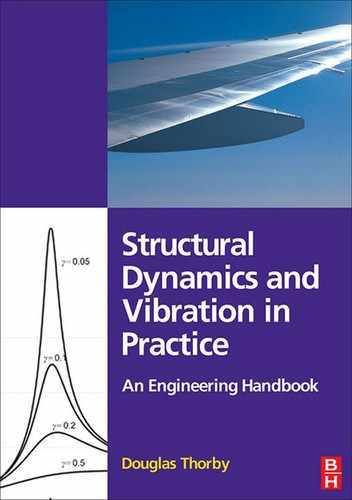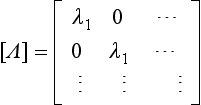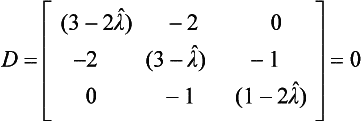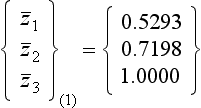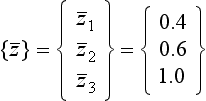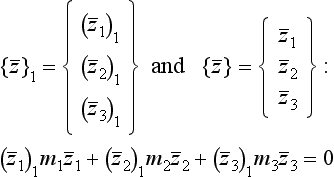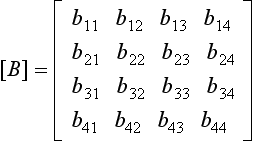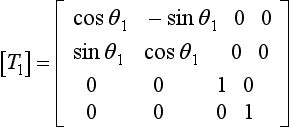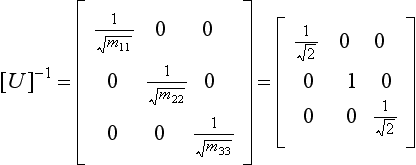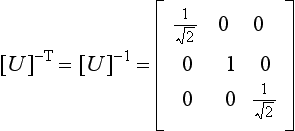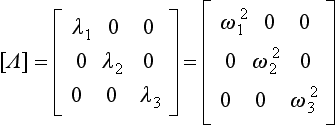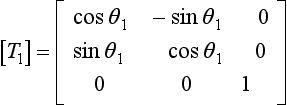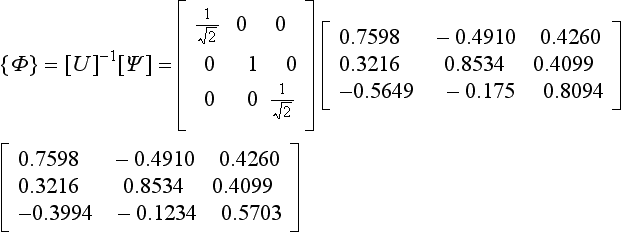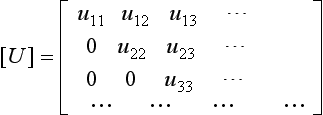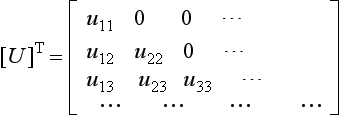Eigenvalues and Eigenvectors
It was shown in Chapter 6 that provided the eigenvalues and eigenvectors of a system can be found, it is possible to transform the coordinates of the system from local or global coordinates to coordinates consisting of normal or ‘principal’ modes.
Depending on the damping, the eigenvalues and eigenvectors of a system can be real or complex, as discussed in Chapter 6. However, real eigenvalues and eigenvectors, derived from the undamped equations of motion, can be used in most practical cases, and will be assumed here, unless stated otherwise.
In Example 6.3, we used a very basic ‘hand’ method to demonstrate the derivation of the eigenvalues and eigenvectors of a simple 2-DOF system; solving the characteristic equation for its roots, and substituting these back into the equations to obtain the eigenvectors. In this chapter, we look at methods that can be used with larger systems.
7.1 The eigenvalue problem in standard form
In Chapter 6, it was shown that the undamped, homogeneous equations of a multi-DOF system can be written as:
or concisely,
wheer
[M] is the (n × n), symmetric, mass matrix, [K] the (n × n), symmetric, stiffness matrix, ω any one of the n natural frequencies and {![]() } the corresponding (n × 1) eigenvector.
} the corresponding (n × 1) eigenvector.
Putting λ = ω2, Eq. (7.2) can be written as:
where λ is any one of the n eigenvalues.
In order to take advantage of standard mathematical methods for extracting eigenvalues and eigenvectors, Eq. (7.3) must usually be converted to the ‘standard form’ of the problem. This is the purely mathematical relationship, known as the algebraic eigenvalue problem:
where the square dynamic matrix, [A], is, as yet, undefined.
Equation (7.4) is often written as:
where the unit matrix [I] is introduced, since a column vector cannot be subtracted from a square matrix.
In Eqs (7.4) and (7.5), although λ is shown as a single scalar number, it can take n different values, where n is the number of degrees of freedom. Similarly, n corresponding eigenvectors, {![]() }, can be found.
}, can be found.
There are now two ways in which Eq. (7.3) can be expressed in the standard form of Eq. (7.5):
(1) The first method is to pre-multiply Eq. (7.2) through by [M]−1, giving:
Since [M]−1 [M] = [I], the unit matrix, this is now seen to be in the standard form of Eq. (7.5):
where [A] = [M]-1[K]; and λ = ω2.
(2) The second method is to pre-multiply Eq. (7.2) through by [K]−1, giving:
Since [K]−1 [K] = [I], this is also seen to be in the standard form of Eq. (7.5):
where ![]()
The matrices [A] and [![]() ] are not the same, but both can be referred to as the dynamic matrix. In general, these matrices are not symmetric, even though both [M] and [K] are. The eigenvectors, {
] are not the same, but both can be referred to as the dynamic matrix. In general, these matrices are not symmetric, even though both [M] and [K] are. The eigenvectors, {![]() }, given by the two methods are identical, but it can be seen that the eigenvalues produced by the two methods are not the same. In the first case, λ = ω2, and in the second case,
}, given by the two methods are identical, but it can be seen that the eigenvalues produced by the two methods are not the same. In the first case, λ = ω2, and in the second case, ![]() .
.
Both of the above ways of defining the dynamic matrix, are in common use. It should be noted that the first method uses the stiffness matrix, [K], and the second method uses the flexibility matrix, [K]−1.
There are many methods for extracting eigenvalues and eigenvectors from the dynamic matrix, and some of these are discussed in Section 7.2.
7.1.1 The Modal Matrix
When matrix transformation methods are used, it is often convenient to form the eigenvectors into a single matrix known as the modal matrix. Then Eq. (7.3),
can be written as:
where [Φ] is the modal matrix formed by writing the eigenvectors as columns:
and [Λ] is a diagonal matrix of the eigenvalues:
Similarly, when the equation is in the form of a dynamic matrix, such as Eq. (7.5),
it can be written as:
where [Φ] and [Λ] are defined by Eqs (7.11) and (7.12), respectively.
In Eq. (7.3), although it is possible to find n eigenvalues and n corresponding eigenvectors, they do not necessarily all have to be extracted. This may be justifiable on physical grounds; for example, we may not be interested in the response of the system above a maximum frequency component in the applied forcing. Therefore, although the matrices [M] and [K] in the foregoing discussion will always be of size n × n, as will the dynamic matrix [A] or [![]() ], the modal matrix, [Φ], may be a rectangular matrix of size n × m (i.e. n rows and m columns), where m ≤ n. The diagonal matrix of eigenvalues, [Λ], will then be of size m × m. It should be pointed out, however, that some methods for extracting eigenvalues and eigenvectors require all n to be found.
], the modal matrix, [Φ], may be a rectangular matrix of size n × m (i.e. n rows and m columns), where m ≤ n. The diagonal matrix of eigenvalues, [Λ], will then be of size m × m. It should be pointed out, however, that some methods for extracting eigenvalues and eigenvectors require all n to be found.
7.2 Some basic methods for calculating real eigenvalues and eigenvectors
Only a brief introduction to this quite complicated subject can be given. The following basic methods are described in this section:
(a) Eigenvalue (only) extraction from the roots of the characteristic equation. The eigenvectors can then be found by substituting the eigenvalues back into the equations, and extracted using one of several methods, of which Gaussian elimination is used as an example below.
(b) Matrix iteration, giving both the eigenvalues and the eigenvectors.
(c) Jacobi diagonalization. The Jacobi method requires a symmetric dynamic matrix as input, and since [A] and [![]() ] are not naturally symmetric, this must first be arranged. If both the mass and the stiffness matrices are fully populated, Choleski factorization is used to ensure that the dynamic matrix is, in fact, symmetric. If, as is often the case, either the mass matrix or the stiffness matrix is diagonal, a much simpler method can be used.
] are not naturally symmetric, this must first be arranged. If both the mass and the stiffness matrices are fully populated, Choleski factorization is used to ensure that the dynamic matrix is, in fact, symmetric. If, as is often the case, either the mass matrix or the stiffness matrix is diagonal, a much simpler method can be used.
7.2.1 Eigenvalues from the Roots of the Characteristic Equation and Eigenvectors by Gaussian Elimination
Finding the eigenvalues from the roots of the characteristic equation has already been demonstrated for a 2 × 2 set of equations in Example 6.3. The following example further illustrates the method, and goes on to find the eigenvectors by Gaussian elimination.
7.2.2 Matrix Iteration
This method extracts both eigenvalues and eigenvectors from the dynamic matrix. Its use is illustrated by the following example, where the flexibility matrix [K]−1 rather than the stiffness matrix [K] is used. Since the matrix iteration method always finds the mode with the largest eigenvalue first, it can be seen from Eq. (7.9) that this will correspond to the lowest natural frequency, and this is usually desirable.
7.2.3 Jacobi Diagonalization
So far we have considered two forms of the eigenvalue problem: (1) From Eq. (7.7):
where
(2) From Eq. (7.9):
where
Unfortunately, both [A] and [![]() ] are non-symmetric matrices, and cannot be used directly in the Jacobi diagonalization, which requires the dynamic matrix to be symmetric. It can always be made symmetric, however, by applying a suitable transformation to the eigenvectors:
] are non-symmetric matrices, and cannot be used directly in the Jacobi diagonalization, which requires the dynamic matrix to be symmetric. It can always be made symmetric, however, by applying a suitable transformation to the eigenvectors:
where [U] is a square matrix, as yet undefined, equal in size to both [M] and [K], [U]−1 its inverse and {![]() } the transformed eigenvector.
} the transformed eigenvector.
To define the matrix [U], we return to Eq. (7.2):
and substitute Eq. (7.14) into it:
Equation (7.15) is now pre-multiplied by the transpose of [U]−1, i.e. ![]() , which can be written [U]−T:
, which can be written [U]−T:
We now consider two cases, which also define the matrix [U]:
We let [M]=[U]T[U], and substitute it into Eq. (7.16):
But since both [U]−T[U]T and [U][U]−1 are equal to [I], the unit matrix, Eq. (7.17) simplifies to
or
where λ = ω2 and
Let [K] = [U]T[U] and substitute this into Eq. (7.16):
which simplifies to
where in this case ![]() and
and
Equations (7.19) and (7.22) are both now in the standard form required, and the new dynamic matrix, whether it is [B], given by Eq. (7.20), or [![]() ], given by Eq. (7.23), depending upon which of the above methods is used, will be symmetric, as required for the Jacobi method of solution.
], given by Eq. (7.23), depending upon which of the above methods is used, will be symmetric, as required for the Jacobi method of solution.
The Jacobi method can now be used to find the eigenvalues and eigenvectors of either Eq. (7.19) or Eq. (7.22). To demonstrate the method we can represent either case by:
However, if [B] represents [B], then λ = ω2, but if [B] represents [![]() ], then λ = 1/ω2.
], then λ = 1/ω2.
For the Jacobi method, Eq. (7.24) is written in terms of the desired modal matrix, [Ψ], i.e. in the form of Eq. (7.13):
where
and [Λ] is the desired diagonal matrix of the eigenvalues, λi, these being equal to either ω2i or 1/ω2i, depending on whether the dynamic matrix was formed by using the method of Case 1 or Case 2 above.
The Jacobi method relies on the fact that, provided [B] is a symmetric, real matrix, then,
where [Ψ] and [Λ] are defined above.
If we apply a series of transformations [T1], [T2], [T3], etc., to [B] in the following way:
and so on, then provided the transformations are such that the off-diagonal terms in [B] are removed or reduced with each application, then [B] will eventually be transformed into [Λ], and the matrix of eigenvectors, [Ψ], will be given by the product of all the transformation matrices required to achieve this, i.e.,
Now a 2 × 2 symmetric matrix, say,  , can be transformed into diagonal form, in one operation, by a transformation matrix:
, can be transformed into diagonal form, in one operation, by a transformation matrix:
that is
It can be shown, by equating the terms in Eq. (7.31), that the value of θ required to achieve this is given by:
If it is desired to diagonalize a larger matrix, say the following 4 × 4 symmetric matrix,
it must be carried out in stages. The terms in [B](1) corresponding to b12 and b21, i.e. b(1)12 and b(1)21, where the superscript(1) indicates that these elements belong to [B](1), can be made zero by the transformation:
where
and θ1 is given by
Similarly, the terms b(2)24 and b(2)42 in [B](2) can be made zero by applying:
where
and
It may then be found that elements b(1)12 and b(1)21 in [B](2) have become non-zero, but their absolute values will be smaller than those of their original values, b12 and b21. Further sweeps may be necessary to reduce them, and all other off-diagonal terms, to some acceptably small tolerance.
This procedure is illustrated numerically in Example 7.3.
It must be remembered that the dynamic matrix was made diagonal by a coordinate change, Eq. (7.14),
and, of course, if the Jacobi method is used on the matrices [B] or [![]() ], the eigenvectors found will be the {
], the eigenvectors found will be the {![]() }, not the {
}, not the {![]() }. To obtain the eigenvectors relevant to the physical problem, {
}. To obtain the eigenvectors relevant to the physical problem, {![]() }, they must be transformed back, using the relationship {
}, they must be transformed back, using the relationship {![]() } = [U]−1{
} = [U]−1{![]() }.
}.
Although we have defined the matrix [U] as being given by either [M] = [U]T [U] or by [K] = [U]T[U], we have not yet discussed how it is evaluated. In general, if the matrices [M] and [K] are both non-diagonal, Choleski decomposition, described later in Section 7.3, will be required to find the matrix [U], and hence [U]T, [U]−1 and, [U]−T. However, if either [M] or [K] is diagonal, [U], [U]−1, etc. are of particularly simple form, and can be derived very easily. This is illustrated by the following example.
7.3 Choleski factorization
In Example 7.3, advantage was taken of the fact that the mass matrix, [M], was diagonal, which enabled the transformation matrix [U]to be found very easily. It was then easy to form the dynamic matrix [B] in symmetric form, by Eq. (7.20), as:
This does not work if the matrices [M] and [K] are both non-diagonal, and in this, more general, case, Choleski factorization has to be used to find [U].
We saw in Section 7.2.3 that
(1) If the mass matrix [M] can be decomposed into [M]=[U]T[U], then the transformation [U]−T[M][U]−1 makes the mass matrix into a unit matrix and the transformation [U]−T[K][U]−1 makes the stiffness matrix symmetric.
(2) If the stiffness matrix [K] can be decomposed into [K]=[U]T[U], then the opposite happens, the transformation [U]−T[K][U]−1 produces a unit matrix, and [U]−T[M][U]−1 is a symmetric mass matrix.
Either way, the dynamic matrix becomes symmetric, as required by many eigenvalue/eigenvector extraction programs.
In the Choleski factorization, [U] is written as an upper triangular matrix of the form:
and its transpose [U]T is
This means that, depending on whether [U] is derived from [M]=[U]T[U] or from [K]=[U]T[U], the products [U]−T[K][U]−1 and [U]−T[M][U]−1 will either be equal to the unit matrix, [I], or be symmetric, and in either case a symmetric dynamic matrix will result.
It can now be seen why the matrix [U] is so named; it is because it is an upper triangular matrix. It should be pointed out that some authors define the basic matrix as the lower triangular matrix, [L]. This makes little difference, since for a triangular matrix [U] = [L]T and [L] = [U]T and so [U]T[U] = [L][L]T. Then [M] or [K] can be decomposed into [L][L]T. However, we will stay with the [U] convention.
Decomposing either [M] or [K] into the form [U]T[U] is fairly straightforward, due to the triangular form assumed for [U]. Assuming that [M] is to be decomposed, we can write it as:
By equating corresponding elements on the left and right sides of Eq. (7.42), a general expression for the elements of matrix [U] can be derived.
The matrix [U]−1, the inverse of [U], will also be required. Since
where [U] is known, [U]−1 unknown and [I] the unit matrix, a general expression for the elements of [U]−1 can be found relatively easily, again due to the triangular form of [U]
7.4 More advanced methods for extracting real eigenvalues and eigenvectors
The foregoing description of the Jacobi method gives some insight into how modern methods for extracting real eigenvalues and eigenvectors work. There are now more efficient methods, and although these are beyond the scope of this book, they should be mentioned.
One of these, the QR method is a development of the Jacobi method, with several improvements. The dynamic matrix is decomposed into the product of an orthogonal matrix, [Q], as in the Jacobi method, and an upper triangular matrix, [R]. Diagonalization then proceeds as in the Jacobi method, but the zeros are preserved, so that [R] is formed in a finite number of sweeps. The decomposition of the dynamic matrix required for the QR method is achieved using the Householder transformation.
The Jacobi and QR methods are used to find complete sets of eigenvalues and eigenvectors. When the set of equations is very large, and only the lower frequency modes are required, alternatives are sub-space iteration and the Lanczos method. The latter is a method for transforming the mass matrix to a unit matrix, and the stiffness matrix to tri-diagonal form, before using the QR method.
7.5 Complex (damped) eigenvalues and eigenvectors
As discussed in Section 6.4.2, there are some systems where damping couples the modes significantly, and real eigenvectors cannot be used to define the normal modes. Transformation into normal modes is still possible, but the modes are then complex. The use of such modes is generally beyond the scope of this text, and only a brief introduction of the method is included here.
Suppose that the general equations of motion for a damped multi-DOF system at the global coordinate level are
where [M], [C] and [K] are of size n × n. If the terms of the damping matrix [C] can not be considered to be either small or proportional to [M] or [K], then the eigenvalues and eigenvectors can still be found, but with greater difficulty.
The initial approach is similar to that already used in Section 6.6.1, to express second-order equations of motion as first-order equations of twice the size. This is referred to as working in the state space. First, a column vector,{x}, of size 2n is defined as:
Differentiating with respect to time:
and re-arranging Eq. (7.44) to
Equations (7.45)–(7.47) can be combined as:
where
and
Since we only require the eigenvalues and eigenvectors of Eq. (7.48), the external forces, {F}, can be set to zero, and
where the matrix [A] is of size 2n × 2n. This first-order set of equations can be solved by the substitution:
which is recognizable as an algebraic eigenvalue problem in standard form. Unfortunately, the matrix [A] is not symmetric, the eigenvalues and eigenvectors are, in general, complex, and the eigenvectors are not orthogonal. These difficulties can be overcome, but the reader is referred to more advanced texts [7.1, 7.2] for the details.
